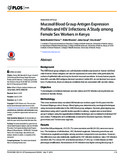| dc.description.abstract | Background
The ABO blood group antigens are carbohydrate moieties expressed on human red blood
cells however; these antigens can also be expressed on some other cells particularly the
surface of epithelial cells and may be found in mucosal secretions. In many human populations
80% secrete ABO antigens (termed ‘secretors’) while 20% do not (termed ‘non-secretors’).
Furthermore, there are disease conditions that are associated with secretor status.
Objective
To investigate correlations between secretor status and HIV infection among female sex
workers in Nairobi, Kenya.
Methodology
This cross-sectional study recruited 280 female sex workers aged 18–65 years from the
Pumwani Majengo cohort, Kenya. Blood typing was determined by serological techniques
using monoclonal antibodies to the ABO blood group antigens. Secretor phenotyping was
determined using anti-H specific lectins specific to salivary, vaginal and cervical blood
group H antigen using the agglutination inhibition technique and correlated to individual HIV
sero-status. Participants were additionally screened for Bacterial vaginosis, Neisseria
gonorrhoea and Trichomonas vaginalis.
Results
Out of the 280 participants, 212 (75.7%) were secretors and 68 (24.3%) were non-secretors.
The incidence of all infections: HIV, Bacterial vaginosis, Neisseria gonorrhoea and
Trichomonas vaginalis was higher among secretors compared to non-secretors. However,
this difference was only statistically significant for HIV infection incidence rates: HIV infected
secretors (83.7%) versus HIV un-infected secretors (71.8%) (p = 0.029) Based on ABO
phenotype stratification, the incidence of HIV infection was higher among blood group A secretors (26/52 = 50%), in comparison to B (12/39 = 33.3%: p = 0.066), AB (3/9 = 33.3%:
p = 0.355), and O secretors (36/112 = 32.1%: p = 0.028).
Conclusion
This is the first report to document the variable expression of the ABH blood group antigens
profiling secretor and non-secretor phenotypes in the female genital tract among a high-risk
population in a Kenyan population. These findings suggest the non-secretor phenotype
may confer a certain degree of protection against HIV infection. | en_US |

